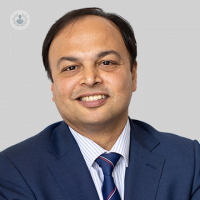How common is infertility?
Written by:As a species, human beings are much less fertile than most other species. While rabbits, for example, can produce multiple litters of up to seven babies in the same year, most human couples will raise between one and three children in their lifetimes. Our relatively low reproductive rate can sometimes cause couples to worry that they have fertility problems. But how common is true infertility in people? What can be done about it? Top gynaecologist and fertility specialist Mr Parijat Bhattacharjee tells all:

Is infertility a common problem?
In a normal menstrual cycle, there is about one in six chance of conceiving – it’s like rolling a die. In most cases, when there is a delay in conception, it’s down to chance. In the UK, about one in seven (almost 3.5 million) couples seek treatment for fertility, but many do not actually need any.
In general, if a couple are unable to conceive after a year of regular unprotected intercourse every two or three days, they should seek medical treatment. If there are other risk factors, like age (i.e. anyone over 35 years of age) should seek help even earlier.
Of course, it takes both partners to successfully have a baby, meaning that the cause of infertility could be in either:
- About 25% of delayed fertility is due to a male factor.
- 25 to 30% is due to an unknown or a combined factor, which could be male or female.
- 25 to 30% is due to a delay or fault in ovulation.
- About 10 to 15% would be due to a structural cause in the woman, such as a fibroid, a polyp, endometriosis, or damage to the tubes from a previous infection.
So, in general, about half of the causes could be either due to a factor in the male or a combined cause and another 40 or 50 percent would be due to female factors.
What causes and increases the risk of infertility?
There are various factors. In the male,
- Lifestyle issues – particularly smoking and drug abuse
- Past infections of the testes, including mumps
- Infections that can affect the tube draining the sperm from the testes
- Trauma to the genitalia
- Complications of hernia surgery
- Anabolic steroids taken for muscle building
As for the female, the commonest cause of delayed fertility is a delay or a lack of ovulation. The most common cause for that is PCOS (polycystic ovarian syndrome). It is primarily a hormonal problem that is related in some ways to diabetes and insulin resistance, and therefore, any gain in weight worsens the condition. Weight management should help prevent this problem from occurring.
There are other hormonal problems, which may even include an early menopause (particularly if there is a family history, e.g. a mother or a sister having early menopause) that can also delay fertility. Drugs can affect ovulation too, including certain drugs used in psychiatry and some drugs used for sickness.
Apart from this, there could be local factors:
- Fibroids – localised swellings of the womb muscles that can distort the cavity of the womb and cause problems
- Polyps
- Endometriosis – bits of lining of the womb can be found scattered within the abdomen (usually in the ovaries and fallopian tubes) and this can affect fertility.
- Previous pelvic infections or surgery can cause scarring and can damage the tubes.
- Ovarian cysts
How does age affect a woman’s ability to get pregnant?
Women are born with a finite number of eggs. From puberty onwards, in every monthly menstrual cycle, a few eggs are recruited, one of which matures and is released into the fallopian tube. This process is called ovulation. In every menstrual cycle a few eggs are recruited and used up. By the age of 35, the number of eggs has decreased drastically, and the chances of fertility thereby decrease as well. By age 40 it reaches a critical level where conceiving becomes very difficult. It is not, however, just the number of eggs; it's also the quality, because the eggs are as old as the woman herself. As the eggs age, their quality decreases, which not only decreases the chances of conception, but it also increases the risk of miscarriages and of chromosomal problems like Down syndrome.
What fertility treatments are available for women?
Nowadays, there are plenty of treatments available. Even though IVF (in vitro fertilisation) has revolutionised fertility treatment and most couples can conceive this way, many do not actually need it. Simple lifestyle changes like stopping smoking and weight management for both the man and woman are often all that's required to get pregnant. Chance is a huge factor in fertility, and therefore, giving it time – particularly if one is young – is important.
There are many other treatments available where there is a cause that can be treated. For example, keyhole surgery can be used to remove a fibroid or a polyp that's distorting the cavity, or to treat endometriosis and scarring inside the pelvis from a previous infection or a surgery. This can be performed as a day case.
Occasionally, a fallopian tube can be blocked and become swollen. Even if one then needs IVF for fertility, the tube (or tubes if both are damaged) – ideally should be removed via keyhole surgery or clipped before going for IVF to increase the success rate.
In minor cases of ovulation problems, simple medications and monitoring in outpatient settings may be all that's needed to achieve fertility. However, if none of these options work, if there's a strong male factor problem, or somebody is over 35 years of age, then IVF or other methods of assisted reproduction could be better options, and there are many available.


